For The First Time, World Learns Truth About Risk Of Nuclear
“We have nothing to fear but fear itself (of nuclear energy).” And now, thanks to some recent research, we know how deadly that fear is.
August 14, 2020
Written by David Watson
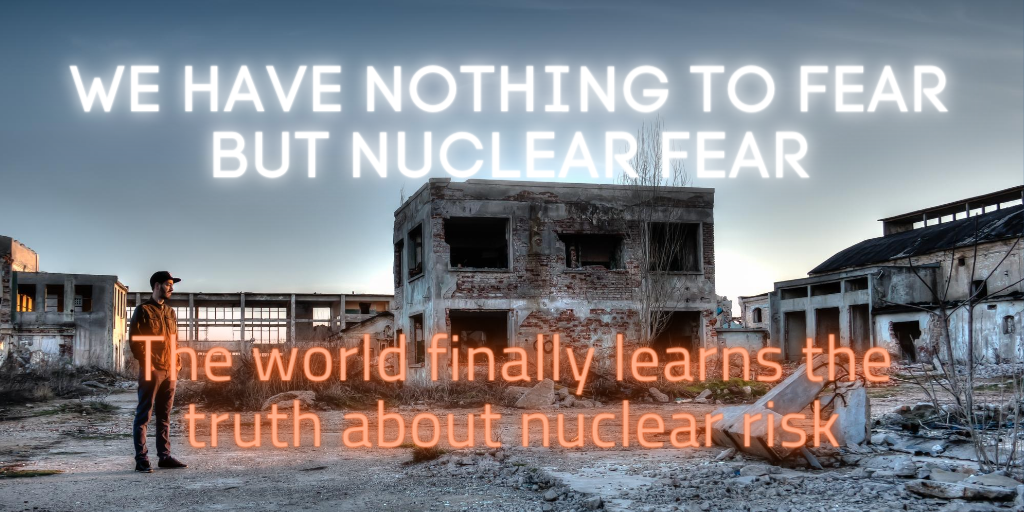
For The First Time, World Learns Truth About Risk Of Nuclear
The public is always asking of nuclear, ‘what if it all goes wrong?’ Data from Chernobyl and Fukushima have now provided the answer.
18 min read
Key points
For those short on time, here are the key take-aways:
- Between 5 and 10 times too many people were moved away from the Chernobyl area between 1986 and 1990
- No one should have been evacuated from Fukushima due to radiation
- If Japan and Germany had reduced coal instead of nuclear after Fukushima, they could have together prevented about 28,000 air pollution-induced premature deaths
- There were 1,121 deaths in the first 3 years from physical and mental exhaustion in Fukushima evacuees, which translates to an average loss of life expectancy from being evacuated greater than the loss of life expectancy people would have incurred by staying put
- Loss of life expectancy in worst-affected Fukushima town less than that experienced by Londoners due to air pollution
- The J-value provides an ethical and mathematically rigorous way to make decisions about what to do during and after a nuclear accident.
- Remediation and food bans are good value for money
- The presumption that long term relocations are a good policy tool needs re-evaluating
This past 11th of March 2020 was the 9th anniversary of the 2011 Fukushima Daiichi nuclear accident. Fears of radiation from the triple meltdown led to the long-term relocation of over 100,000 people. In a landmark study completed in late 2017, a group of UK scientists set out to find the truth about the risk of nuclear. They showed that not only was the scale of this relocation far too large, but that the evacuation itself led to thousands of unnecessary deaths from mental and physical exhaustion.
Despite initial interest from UK and US authorities, little has changed in the way governments plan to deal with future nuclear accidents. In this deep-dive interview with the group’s lead author, I look at why, almost a decade on, governments, regulators and the nuclear industry are so resistant to change, and whether this means we might be sleepwalking into another nuclear public health disaster.
This article was originally published in the UK Nuclear Institute’s Nuclear Future magazine in July 2020.
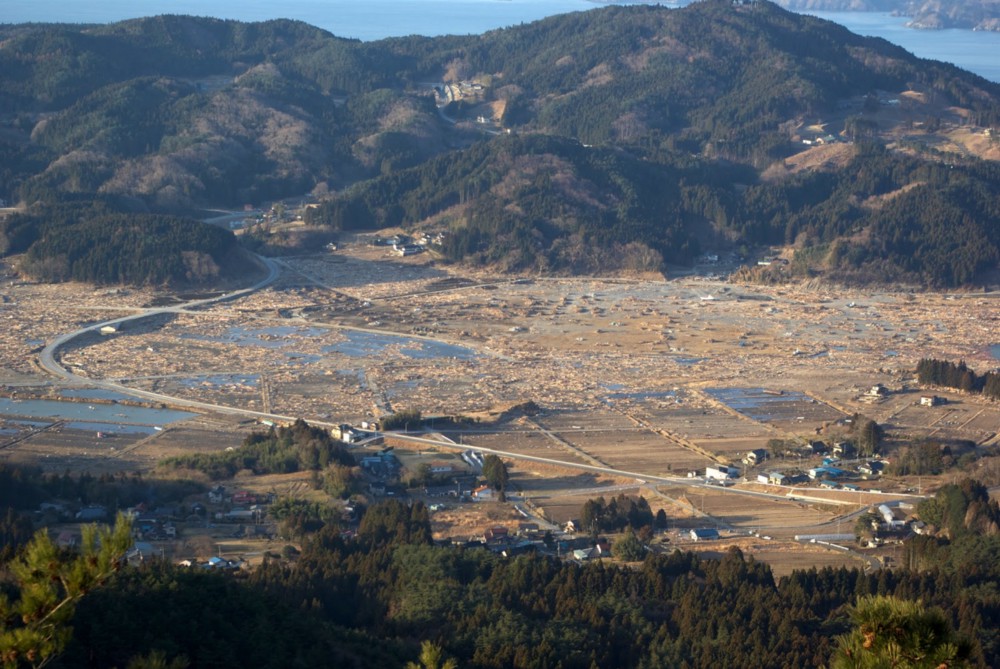
The tsunami turned to rubble whole towns like Rikuzentakata, Iwate.
The 11th of March, 2011, felt like any other Friday in Ishinomaki, Miyagi Prefecture, Japan. In a town known for its oysters, local fishermen rose early to put to sea. Shopkeepers busied themselves with the end of week trade. Office workers sat at their computer screens. At the Okawa elementary school, children practiced their reading and recited their times tables, awaiting the school bell that would announce the weekend. But the school bell never did ring that day, and it hasn’t rung since.
At 14:46 JST a magnitude 9.0–9.1 earthquake occurred 70 km off the coast of Oshika Peninsula. It was the most powerful ever recorded in Japan, and the fourth most powerful ever recorded anywhere in the world. The earthquake moved the main island of Japan 2.4 m to the east, and shifted the whole Earth up to 25 cm on its axis.
More destructive than the earthquake itself was the ensuing tsunami, whose waves reached 40.5 m high, traveled at speeds of 700 km/h and raced up to 10 km inland. Those living close to the sea had little time to react following the earthquake before raging torrents of water, mud and debris engulfed them.
Ishinomaki was one of the worst-affected areas. Along with most of the town, Okawa school was completely destroyed. 74 out of a total of 108 students lost their lives, along with 10 out of the 13 teachers.
The 2011 Tōhoku earthquake and tsunami was a disaster of epic proportions. It killed around 19,000 people and forced the evacuation of hundreds of thousands more. Roads and rail were destroyed. Power lines were toppled, water supply and sewage treatment lost. Schools, workplaces and most government services ceased to operate. Despite this, most of the world associates but one word with this disaster: Fukushima.
The Fukushima Daiichi accident
The earthquake and tsunami victims in Miyagi, Iwate and Fukushima received relatively little media coverage outside Japan, with most airtime given over to grainy shots of the three damaged Fukushima Daiichi plants and rushed TV interviews with nuclear “experts”.
Imagine having everything you know swept away in a tsunami, to lose family and friends under a crashing wave of destruction, only to pick up from TV and radio that the real danger was of you being fatally irradiated by a triple nuclear meltdown. Nuclear radiation must be more dangerous than anything you can possibly imagine.
Very serious decisions were made on the assumption that nuclear meltdowns are the deadliest of all possible accidents. Following the incident, 111,000 people were required to leave areas around Fukushima Daiichi, and an additional 49,000 joined the exodus voluntarily; about 85,000 had not returned to their homes by 2015.
The challenge of mass evacuations
Mass evacuations are not simple things. They mean taking over 100,000 people out of their homes, away from their jobs and their local services. In Japan’s case, you have to find somewhere for them to live on a small, densely-populated island. For the adults, you have to find them a job. For the children, you have to find them a school. Any residents who do stay are now living in a ghost town with no local services, including even basic things like food, water and medicine.
Now, imagine that tens of thousands of the residents are elderly and may have limited mobility and poor health. Some may need caregivers and medical facilities to support them. Some of the adults will have disabilities or mental health problems. Such people are likely to require support to evacuate, and possibly part or even full-time health and social care. Next, consider the potential thousands of hospital patients, some of whose lives may depend on modern hospital equipment, put them onto trolleys, drive them to another hospital and hope they can be taken in.
Remember, all this may be happening in a wider disaster zone, such as happened with the tsunami in Japan. Roads may be blocked, rail infrastructure inoperable, power out, and food and water in short supply. Hazardous chemicals may have been released from nearby industry, such as from the fires at petrochemical plants in Sendai during the Tōhoku tsunami.
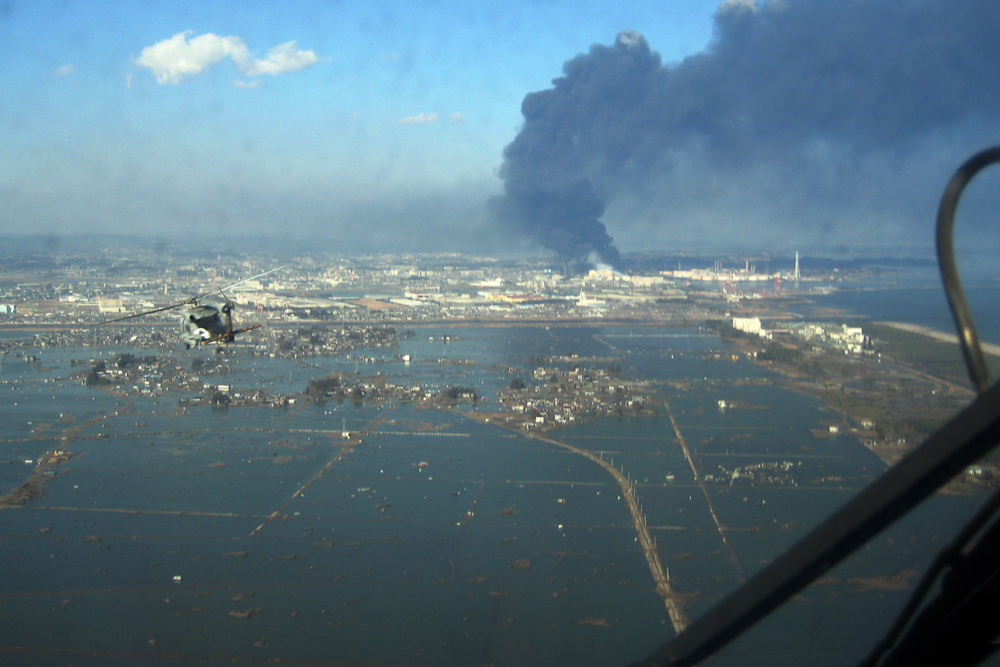
The tsunami turned to rubble whole towns like Rikuzentakata, Iwate.
Consider the mental stress of being relocated, losing your job, your school, your neighbours, as well as the paralysing fear that you and your family have received a potentially fatal dose of radiation (otherwise, why were you evacuated?). As the relocation draws on, imagine the social dislocation this creates. In desperation, you might turn to drinking, smoking or drug abuse. You might start taking excessive risks because you think you’re doomed anyway, or perhaps you retreat into a shell and suffer from PTSD (post-traumatic stress disorder).
All these effects were detected among Fukushima evacuees, as well as those relocated from around the Chernobyl nuclear accident. This begs the question: do such evacuations represent good policy? How do we know whether a mass evacuation is “worth it”? Are there alternatives?
Coping with a nuclear accident
It was with these questions in mind that Professor Philip Thomas of Bristol University started the NREFS project (Management of Nuclear Risk Issues: Environmental, Financial and Safety) in 2012, jointly funded by the UK Engineering and Physical Sciences Research Council (EPSRC) and the Atomic Energy Commission of India.
While accidents at nuclear plants are very rare, it is impossible to say that they will never occur. As Prof Thomas says, “I’ve often met with the reaction that we should make sure accidents don’t happen. And that’s fine. But accidents do happen, they have happened — and what do you do then?” The NREFS project sought to measure objectively the effectiveness of actions (usually referred to as ‘countermeasures’) a government could take following an accident, principally evacuation, sheltering (staying indoors for a period of hours to days), bans on the consumption of locally grown foods, remediation (cleaning of buildings and soils to remove contamination) and long-term relocation.

The tsunami turned to rubble whole towns like Rikuzentakata, Iwate.
Believe it or not, no one had ever before measured — objectively — the effectiveness of such countermeasures, despite the huge social impact they incur. To do this, four independent strategies were developed by academics at Open University, University of Warwick, University of Manchester and City, University of London (Prof. Thomas moved from City to Bristol University during the project). The first strategy was to deploy a tool called the Judgement, or J-value.
Prof. Thomas developed the J-value in the 2000s to help engineers decide which safety systems provided the best value-for-money in terms of safety benefit. Most recently, the J-value has been used to assess the effectiveness of lockdown measures during the COVID-19 outbreak. The J-value builds on a widely-used economics indicator called the Life Quality Index, which is an ethical way to combine life expectancy at birth with gross domestic product (GDP) per person to determine how much money it makes sense to spend on reducing exposure to risk.
Unlike the United Nations’ Human Development Index (HDI), the Life Quality Index is derived rigorously from the economics of human welfare. As governments only have a limited amount of money to spend on all the services they provide, this means that there are not infinite funds to be spent responding to a nuclear accident; £1 spent on evacuating residents is £1 less that is spent on schools, hospitals and roads.
The J-value thus cleverly provides an objective way to measure whether countermeasures such as evacuations are “worth it”. It all gets a bit technical, but the J-value is measuring whether the gain in life expectancy afforded by a countermeasure like evacuation is worth the cost in £s to implement that measure.
As the J-value is a mathematically rigorous approach, economists and statisticians are able to pick apart the methodology and propose tweaks where they disagree. However, there have been no papers that refute NREFS’s findings. And almost uniquely for the social sciences, the NREFS team were able to empirically validate the J-value method by using it to predict life expectancy in 180 out of the 193 countries recognised by the United Nations.
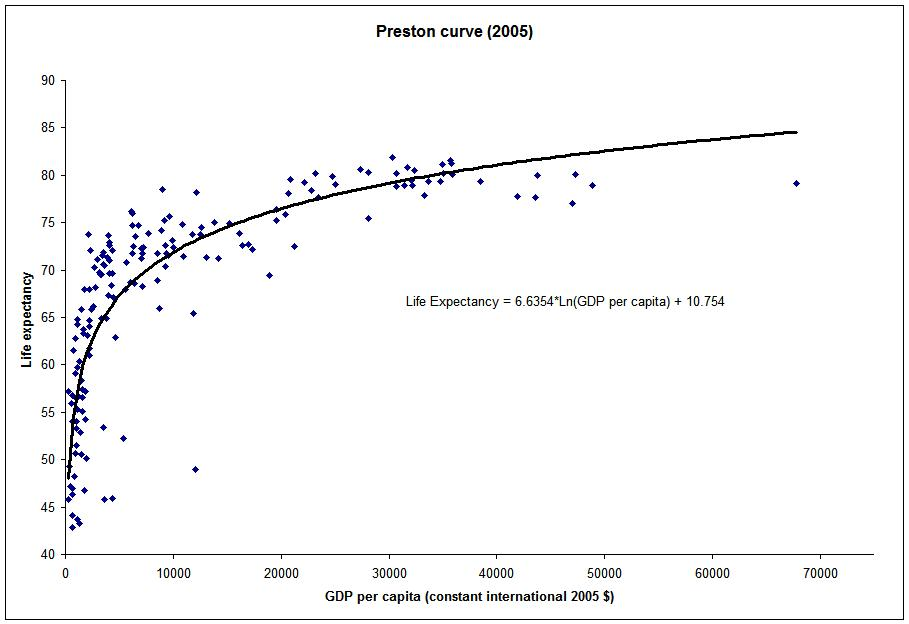
The x-axis shows GDP per capita in 2005 international dollars, the y-axis shows life expectancy at birth. Each dot represents a particular country. (Source: By Radeksz — Own work, Public Domain, https://commons.wikimedia.org/w/index.php?curid=8862417)
The big surprise
A massive 335,000 people were relocated after Chernobyl, never to return. For Fukushima Daiichi, around 111,000 people were forced to evacuate, with close to 50,000 following voluntarily; about 85,000 had not returned to their homes by 2015. Prof. Thomas and his team set about applying the J-value to both these accidents. What they discovered was so surprising that even they found the results hard to believe.
Chernobyl was pretty much the worst nuclear accident imaginable. Due to poor design and mismanagement, the reactor exploded, raining pieces of fuel into the nearby fields and setting alight graphite in the core.
The J-value method suggested that for Chernobyl an evacuation was indeed a good idea. “We looked at Chernobyl,” says Prof. Thomas, “and we came to the conclusion that you would be looking to evacuate people once their loss of life expectancy was greater than 9 months.” As the area around Chernobyl was relatively poor and the cost of moving people was relatively high, the J-value says it would have been better for local people to stay put unless their loss of life expectancy from staying was greater than 9 months.
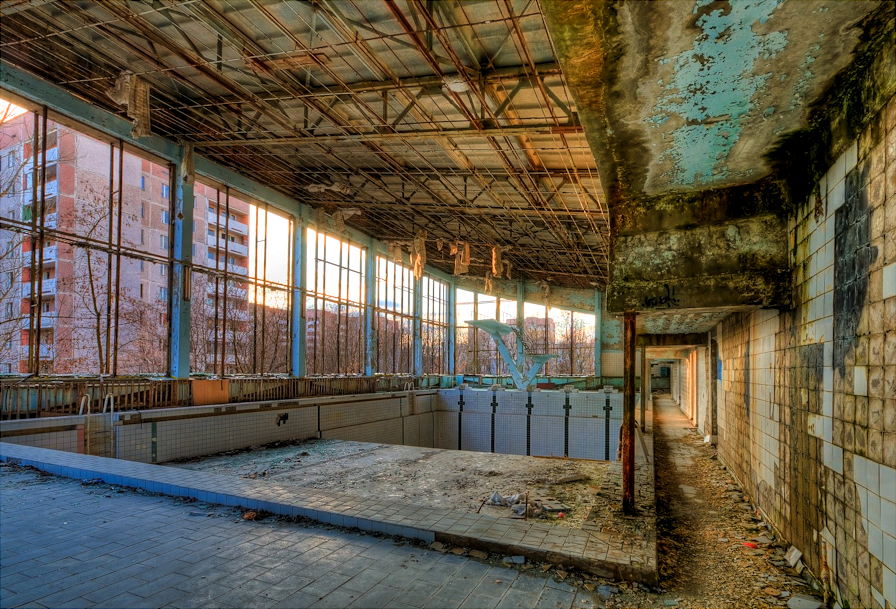
In 2009, over two decades after the Chernobyl incident, the Azure Swimming Pool in Pripyat shows decay after years of disuse (Source: Photo by Timm Suess from Basel, Switzerland — Swimming Pool Hall 4 (Flickr), CC BY-SA 2.0)
Prof. Thomas continues, “Because we had quite extensive data on contamination levels on the various places around Chernobyl, we could work out how many people would be losing that amount of life expectancy. The answers we came back with surprised us.”
The analysis showed that between 5 and 10 times too many people were moved away from the Chernobyl area between 1986 and 1990. The initial evacuation should have been limited to 31,000 people, instead of 116,000. The second evacuation in 1990 of 220,000 people was entirely unjustified, affording a gain in life expectancy of just 24 days.
The surprising results don’t arise from some new, slap-dash way of measuring risk from radiation. The methodology uses approaches recommended by various United Nations committees, including the “Linear No Threshold” model for low doses of radiation, which some radiation experts believe overestimates the risk of a small amount of radiation. “The evacuation was very effective in reducing the dose and increasing life expectancy,” says Prof. Thomas, “but we found that it was well over the top.”
As for measuring the costs of evacuation, “We were very conservative about this,” says Prof. Thomas, “we looked purely at the cost of relocation, and didn’t factor in the economic, social and health costs of the disruption caused by evacuation.” If such effects were factored in, he says, this would reduce the recommended number of evacuees even further.
Prof. Thomas fears that as well as the Chernobyl relocations being far too large in scale, those that were relocated, many of whom received government pensions as accident victims, suffered psychological effects for many years: “A lot of the people evacuated thought, ‘If the government is spending this amount of money on me, I must have suffered something truly dreadful.’ I think there has been enormous psychological damage, which has led to loss of life expectancy in itself.” If such negative effects were accounted for this would also strengthen the argument for no evacuation, or at least only a short, temporary one, Prof. Thomas adds.
So what about Fukushima, where residents affected by the meltdowns were also living in a tsunami disaster zone? The authors found it difficult to justify moving anyone on grounds of the risk from radiation. The average loss of life expectancy from radiation if everyone had stayed put was found to be 19 days.
Prof. Thomas explains that “for the worst-affected town, Tomioka, the loss of life expectancy there would have been less than 3 months, and they shouldn’t have been evacuated at all,” although he noted temporary evacuation may well have been necessary for some due to tsunami and earthquake damage.
To put that in context, the two and a half month loss in life expectancy in Tomioka would have been less than the four and a half months loss of life expectancy experienced by all Londoners due to air pollution.
Sadly, of the 160,000 people evacuated due to radiation fears, there were 1,121 deaths in the first 3 years from physical and mental exhaustion. This translates to an average loss of life expectancy due to being evacuated of 37 days, which is more than the loss of life expectancy people would have incurred by staying put.
One interesting finding was that remediation, i.e. the cleaning and decontaminating of urban and agricultural areas, was found to be very good value-for-money. Food bans were also found to be effective.
The J-value was just one aspect of NREFS. Mathematicians at the University of Manchester performed an independent economic analysis looking at hundreds of potential nuclear accidents around the world. Prof. Thomas explains they concluded that “in very few cases was it sensible to relocate anyone permanently [following an accident]. In some cases it might be an idea to move people out temporarily, for a month or so, look at remediation and other things, but to get them back home.”
A third approach managed by the Open University and Public Health England (the public body in the UK responsible for human health issues, including those related to radiation) used the latest computer modelling tools to predict what would happen if there were an accident at a fictional nuclear reactor on the English South Downs. “[The researchers] came to the conclusion that, on average, long-term relocation would be limited to around 600 people,” says Prof. Thomas.
The only rebuttal to NREFS’s findings was in the form of a letter from a group of history and communications academics (Kasperski et al.) who questioned the J-value methodology, as well as some of the NREFS team’s assumptions. Prof. Thomas believes that their reply addressed all of the points raised in the letter.
Ground-breaking results
NREFS surprised everyone. Even the authors found it hard to believe what the numbers were telling them. The results seem to fly in the face of everything society assumes about the risk of nuclear accidents.
The papers were published in a special issue of Process Safety and Environmental Protection in December 2017. At close to 40,000 downloads, it’s among the top 5 downloaded issues of all time. Prof. Thomas and his team were invited to present their findings at the UK All-party Parliamentary Group for Nuclear Energy, as well as at the US Federal Emergency Management Agency, the American Nuclear Society, an Anglo-French cooperation event at the British Embassy in Paris, and many international conferences on radiation protection.
In Japan, where the NREFS findings are perhaps most sensitive, the response was overwhelmingly positive. Prof. Thomas was invited to speak at Fukushima Medical University and Hiroshima University, and has even been awarded a Japan Society for the Promotion of Science International Fellowship for 2020, which will see him work with local universities on remediation at Fukushima.
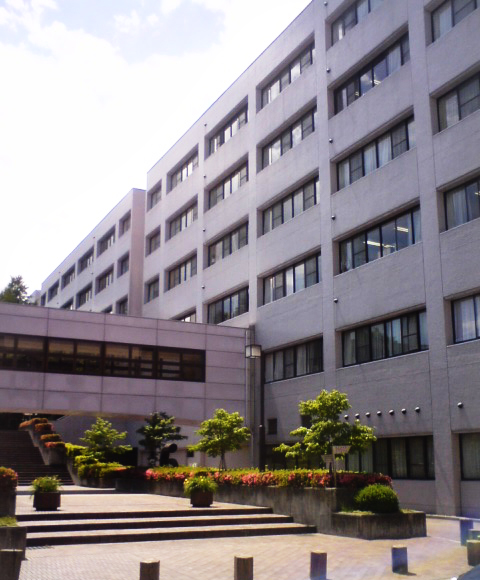
Fukushima Medical University (Source: Photo by Kozo — 投稿者により撮影, Public Domain)
“One of the things we’re keen to avoid is putting any blame on Japanese authorities,” says Prof. Thomas. “No one has experience of this, we’ve only had one big nuclear accident [before Fukushima], and they more or less copied the mass evacuations that happened at Chernobyl. They didn’t have the benefit of our work — no one knew better at the time. The key thing is that anything that happens from now on needs to bear [our findings] in mind.”
Scientists at Fukushima Medical University and Hiroshima University have independently reached the same conclusions as the NREFS project: that the scale and duration of the Fukushima relocations cannot be justified based on the risk from radiation. They also looked at public perception of the severity of the accident and found that the further away from Fukushima Daiichi you lived, the worse you believed the accident to have been.
Nuclear in the media spotlight
For an academic project, NREFS received significant media coverage. The project’s launch was covered by The Times (of London) newspaper, with follow-up pieces from the Financial Times, among others. Amusingly, The London Evening Standard picked up on the London air pollution statistic and turned it on its head: “Living in London ‘poses same risk to health as living in nuclear fallout zone’”, read the headline. The story went viral.
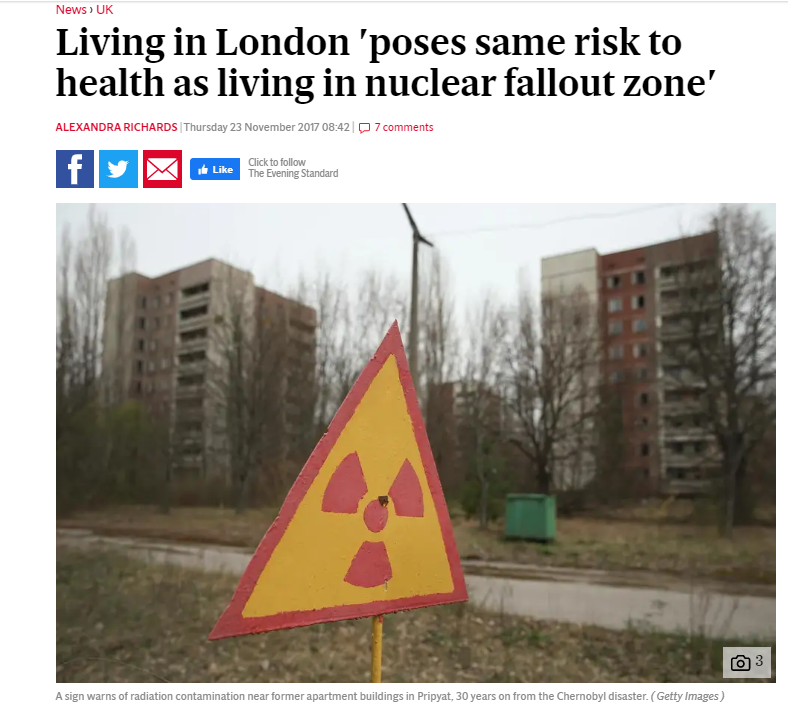
The headline sums up the difficulty Prof Thomas and co. faced: most people’s starting point is that nuclear is dangerous. If air pollution in London poses more risk than living in a nuclear accident zone, it must be that air pollution is incredibly damaging rather than that radiation is less scary than we thought, so the thinking goes.
Prof. Thomas thinks most people simply find it hard to believe that the group’s findings can possibly be true. This includes the nuclear industry itself, which as an academic Prof. Thomas is keen to distance himself from.
“The nuclear industry has been losing the argument for the last forty years, ever since Three Mile Island,” he says, “and now can’t quite believe the good news [that the main issue which has dogged them for so long may be less serious than was feared]”. Prof. Thomas insists that “if you do have a nuclear accident, a big nuclear accident, a massive nuclear accident, then you shouldn’t panic. The consequences are far less than people have feared.”
Have we learned the lesson NREFS provides?
Despite the apparently broad interest and ground-breaking findings, Prof. Thomas believes that almost no country is seriously rethinking how to deal with nuclear accidents. He believes if there were a nuclear accident tomorrow then a lot of the mistakes from Fukushima and Chernobyl would be repeated.
“We have actually met quite a lot of resistance from the UK Health & Safety Executive (HSE) and the Office for Nuclear Regulation (ONR),” he says. Although someone within ONR made reference to the NREFS results as part of a report on the mothballed Hitachi-GE Wylfa Newydd project, ONR have not formally sought Prof. Thomas’s advice on the subject.
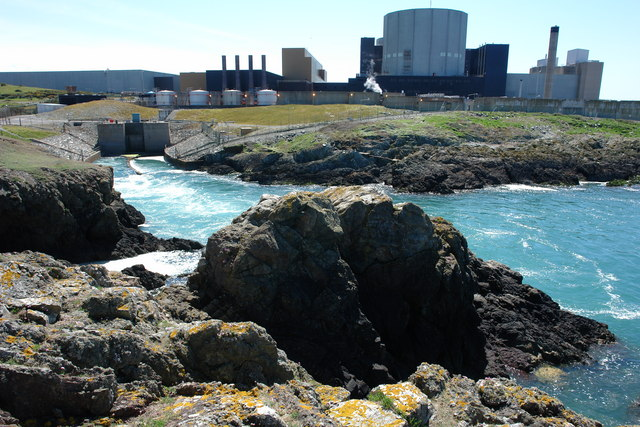
The now decommissioned Wylfa A power station.
Prof. Thomas gave a short lecture to the HSE and had a meeting with the UK government department responsible for nuclear (Department of Business, Energy and Industrial Strategy, BEIS), which he says seemed to go well. However, there was no follow-up from BEIS, and neither he nor his team have been invited to advise the UK government directly on its Emergency Preparedness and Response guidelines.
When questioned on this, a BEIS spokesperson said that “We considered Prof. Thomas’ response to a public consultation in October-November 2017 on revising our Emergency Preparedness and Response (EP&R) arrangements for radiological sites. Consultation responses helped to shape and finalise our final policy positions. The REPPIR 2019 regulations that were introduced as a result provide a single set of updated EP&R requirements at radiological sites across multiple sectors. Our proposals received broad support from respondents.” However, the government’s response to that consultation did not address Prof Thomas’ comments relating to the use of prescriptive exclusion zones, or those highlighting the dangers of mass relocations based on experience from Chernobyl and Fukushima.
Although the ONR and Public Health England (who advise the government on public health issues) did not respond to our request for comment, the approved code of practice developed by ONR to support the implementation of REPPIR 2019 does encourage that “protection strategies should be optimised and require a balance to be struck between the expected benefits and detriments of introducing particular protective actions.”
However, Prof. Philips believes the guidance from government is not strong enough: “The presumption should be that we don’t carry out massive relocations, and any evacuations that do take place should be fairly limited and temporary.”
J-value as tool for real-time risk-monitoring
Perhaps there has been limited government interest because the J-value is not much use if we can only apply it some months or years after an accident. For J-value to be really useful it has to be available on-demand to incident controllers during an accident. To this end, Prof. Thomas is working with the Indian authorities to augment their online nuclear emergency response system, known as ONERS.

The ONERS system would monitor dose in real-time use drones and AVs (Photo by Karl Greif on Unsplash)
Using the J-value, weather data and real-time radiation levels collected by swarms of drones and autonomous vehicles, ONERS could provide residents around a nuclear plant with real-time risk data during an accident via an app on their phone. As evidence shows people intuitively understand life expectancy, the risk would be displayed as the likely loss of life expectancy from the accident, including J-values for countermeasures like sheltering or evacuating.
In fact, Prof. Thomas “would like to see this app being accessible every day of the year. People all over the world have smartphones, and they could see daily the risk the plant is posing to them.” There has been real interest in the project from India, Japan and the US, but so far none from the UK or EU. “It’s disappointing that the UK has not shown more interest,” he says, “it would be great if we had strong support for future research.”

People living near a nuclear plant could access real-time risk measurements on their smartphone (Photo by Sara Kurfeß on Unsplash)
The beauty of the J-value is that it is both objective and auditable. As the method has a mathematical basis, decision-makers using J-value are then able to defend their decisions after the fact. This could alleviate some of the enormous pressure placed on decision-makers during a nuclear accident, and avoid the overconservative thinking we saw at Fukushima and Chernobyl, as well as the unnecessary evacuation deaths this led to.
The danger of fearing radiation
Our fear of nuclear has slowed the expansion of new nuclear power. This means more fossil fuels, more air pollution (which kills 7 million people a year), more global warming, more habitat destruction. This fear is dangerous stuff.
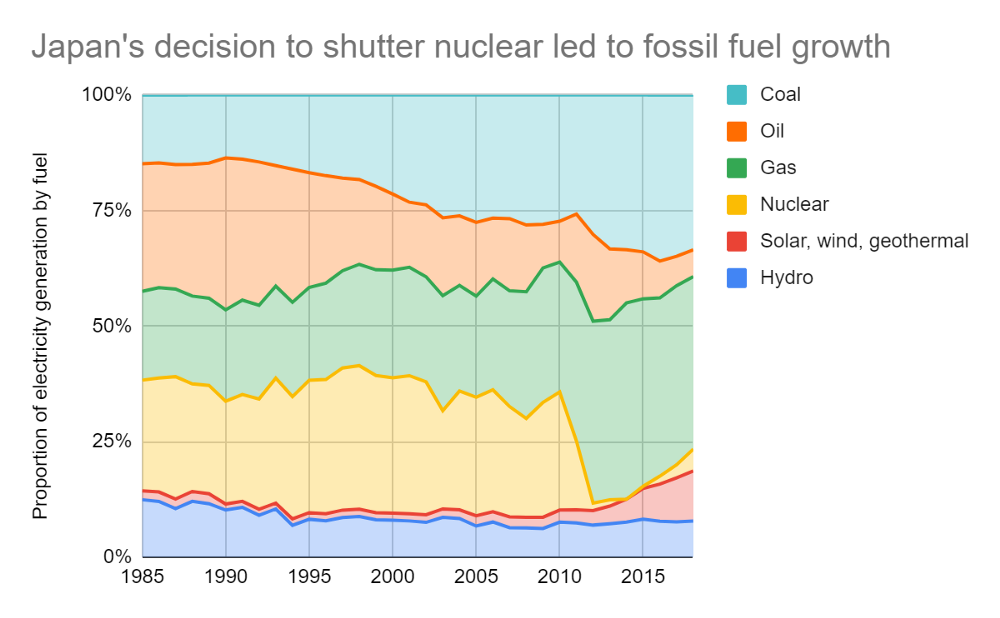
As the climate science website Carbon Brief puts it, “[Following the Fukushima Daiichi accident], Japan quickly cut back on its use of nuclear energy and by 2013 it had shuttered all its nuclear plants. A large expansion of gas and oil provided the missing power.”
Responding in a proportionate way to nuclear accidents affects the whole planet through carbon emissions and air pollution. In fact, research from leading climate scientists suggested that if Japan and Germany had reduced coal instead of nuclear after Fukushima, they could have together prevented about 28,000 air pollution-induced premature deaths and 2.6 billion tons of CO2 emissions between 2011 and 2017.
Our understanding of nuclear accident risk may also influence the success or otherwise of next-generation advanced nuclear reactors, many of which aspire to be co-located with industry or urban areas. Currently, nuclear plants are mostly sited far away from population centres due to safety fears. The work of Prof. Thomas and his team suggests we should at least re-evaluate this policy.
What does the future hold for nuclear?
Prof. Thomas’s team did not have an agenda: “the results were a surprise to everyone on the project team”, he says. “But when we take a step back…if our results are correct then we must change the way we perceive nuclear power.”
So, what is the truth about the risk of nuclear? “The public is always asking of nuclear, ‘what if it all goes wrong?’ Now, for the first time ever, we have an answer, and it’s quite an encouraging answer at that.”
As you read this we could well be sleepwalking into another nuclear public health disaster. If there was a meltdown tomorrow in the UK, France, US or elsewhere, it’s likely that our failure to adjust our thinking in light of the experiences at Fukushima and Chernobyl would mean we evacuate too many people for too long. People would die as a result.
“If Japan and Germany had reduced coal instead of nuclear after Fukushima, they could have together prevented about 28,000 air pollution-induced premature deaths.”
Revisiting our assumptions about nuclear accidents will not be easy, but we have to try. Everyone has an interest in doing so. Government and regulators have an interest, because evidence from Japan shows that overreacting could be fatal. The nuclear industry has an interest, because a single badly-handled nuclear incident would cause the complete shutdown of the sector, just as happened in Japan. The public has an interest, because on a planet already overwhelmed with fossil fuels and habitat destruction, a billion people still lack access to electricity. Rediscovering nuclear as a safe energy source, as well as a green and affordable one, would be revolutionary.
This article was originally published in the UK Nuclear Institute’s Nuclear Future magazine in July 2020.
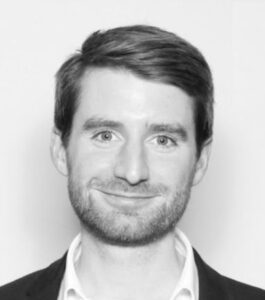
WRITTEN BY
David Watson
Ecopragmatist, clean energy advocate, believer in pedal power. Editor of Generation Atomic.


